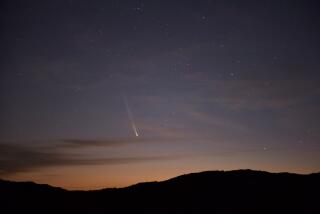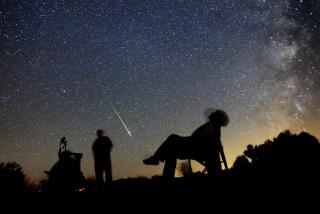Comet Tales : 100 Gather at Pomona College for Faint Glimpse of Heavenly Body’s Fall Toward Sun
- Share via
The last time Halley’s comet swung by on its exaggerated orbit around the sun, Lorena Cole was vaguely uneasy. The century had turned just 10 years earlier, she was only 7, and some of the adults she knew were afraid of what the dazzling streak of light in the night sky might portend.
People were making frightening predictions about what would happen when the comet passed by. Earthquakes, fire, death by poison gas and plague were heralded as inevitably intertwined with the looping path of the comet itself. Nothing was beyond the realm of possibility because next to nothing was known about the comet.
The comet was close enough to Earth last Friday for Cole and about 100 others to see it through telescopes at Pomona College as a bright pinpoint surrounded by a cloud of light, the boiled-off gas that will eventually become a tail several million miles long.
First Appearance in 75 Years
Cole, now 82, and the others were invited to view the comet, which is making its first appearance in 75 years, by the Pomona Valley Amateur Astrononomer’s Assn.
The amateur astronomers took advantage of the sudden interest in the comet to show off their telescopes and knowledge, and perhaps to gain a few more members.
But Cole, of Claremont, said the madness and hysteria she sensed as a little girl seems to have all but disappeared in 1985.
“I remember they were so frightened,” Cole said. “I stayed overnight with a little friend and her family was fighting about it. All I remember is a star with a tail.
“I think there’s a greater awareness now,” she said. “People know what to expect and when.”
Today more is known about what comets are made of, where they come from and why it takes them so long to get here. Nearly 80 years of diligent astronomy has taken most of the fun out of being superstitious.
“It’s a different kind of hysteria now,” said Alma Zook, a Pomona College astronomer and assistant professor who was on hand to help first-time comet hunters find their target.
“It’s more of a commercial hysteria,” she said. “At this time in 1910 people were genuinely afraid of being killed by the comet. Now it’s, ‘Let’s jump on the bandwagon and make hats and T-shirts.’ Comet fever is probably the better word.”
“The comet is just a come-on,” said David Chandler, a Pomona teacher who is president of the association. “That’s not the real point of it. You can see a lot of other objects out there; nebulas, galaxies, double stars . . . “
The night’s comet hunt began in a Pomona College lecture hall, where the head of the college’s astronomy program, Prof. Robert Chambers, gave a short talk on Sir Edmund Halley, the first man to accurately predict the comet’s orbital cycle in 1687.
After the astronomy association members followed up with a lengthy presentation of comet facts, the gathering moved to a wide lawn near the center of campus. It was here that the comet-watching began in earnest. A three-block mid-campus area had been darkened for the
purpose.
A line formed in the dark behind the 10-foot-long telescope that had been set up on the lawn by the association. Several other members of the amateur club had set up their own telescopes and shorter lines formed behind those.
The people who climbed up a creaky wooden ladder to the Astronomer Assn.’s homemade 24-inch refractor telescope saw what most described as a “fuzzy dot.” Viewers could not see whatever tail the comet might have, astronomers said, because at this point in its orbit the tail is pointed directly away from Earth. Astronomers are expecting to see little else before the comet dips below the western horizon on its way to a rendezvous with the sun Feb. 9.
Scientists get excited about comets because they believe they are pieces of the primal stuff that condensed to form the solar system. During that formation, the matter that makes up the planets collapsed and heated under its own gravity, changing it forever. But the comets, astronomers say, apparently skipped that infernal process, and may give important clues about how the sun and planets came into being.
Rare Chance
Most of the people who came to see Halley’s comet, however, got excited for different reasons.
“It’s a once-in-a-lifetime chance,” said Margaret Greever of Claremont. As for what she saw through the massive telescope: “There was a little fuzzy thing in there.”
“It will be better in April when it has its tail,” said Kathy Ellworth of Alta Loma.
Most of the comet-watchers were somewhat underwhelmed by the object itself and were more interested in its historical implications.
“People get very maudlin about the comet,” said Michael Linn of Claremont. “It reminds me of the Battle of Hastings, things like that,” said Linn, referring to the appearance of Halley’s comet in 1066, just a few months before the battle in which King Harold of England was defeated by the Norman army. Comet enthusiasts throughout history have attributed the defeat to the presence of the comet.
“I think it’s very weird,” said Linn’s 8-year-old son, Ian.
“It does tend to show up during very important events,” said Linn’s wife, Ellen. “But I don’t think it’s going cause any problems this time. It’s too far away probably to make any difference.”
Comet Joke
Brendon Vaughan, 5, of Pomona, was compelled by his father, George Vaughan, to tell a joke from an undisclosed comet joke book.
“Why did the comet cross the universe?” asked Brendon, then gave the eternal reply: “To get to the other side.”
Meanwhile, there were some other unusual descriptions of the comet as viewers stepped off the rickety ladder. “Spiderweb,” “cotton ball,” “furry” and, simply and clearly, “white.”
Charles W. Helsley, 92, of Clarmont said he came merely to get a better look at the comet than he’d had the first time.
That was in 1910, in Denison, Iowa, which was a little too far north, he said, to get a good view of the comet’s tail.
“I was a little bit disappointed then,” Helsley said. “I wanted to see how much more of it I could see this time.”
The view last Friday was not particularly impressive either, Helsley said later. “At this stage it isn’t as attractive as it is when it’s been heated up a little bit more by the sun,” he said. “I’m going to follow everything that happens to it. When you think of it all these years traveling at terrific speeds and now it’s back again just as they said it would be. I never expected to see it again, you know.”
As if somehow aware that it will not inspire quite the fear that it did 75 years ago, the comet will not make as spectacular a showing this time around, astronomers predict. The best viewing will be in the Southern Hemisphere in mid-March and mid-April, when the comet has swung around the sun and is on its way out of inner solar system.
For Southern Californians and people in the Southern United States, the best time to see it will be immediately after sundown during most of December, when it will appear in the southwestern sky. After it skirts the sun in February, it will appear again in March on the eastern horizon and, astronomers predict, will be much brighter. Unfortunately, the viewing will have to be done between about 3 a.m. and just before sunrise.
Still keenly aware of the disappointing view of comet Kahoutec in 1973, astronomers as a whole are being conservative with their estimates of Halley’s brightness.
Many predicted that Kahoutec would be bright enough to see with the naked eye during the day, but it turned out to be so dim it could hardly be seen at night, even with a telescope.
“We ended up with a lot of egg on our faces,” astronomer Zook recalled.






